Kiriri
- Self-denomination
- Where they are How many
- BA 2806 (Siasi/Sesai, 2020)
- Linguistic family
Kiriri is a Tupi Word that means “silent”, “taciturn” people. This name is supposed to have been given by the Tupi of the coast to the Indians who inhabited the backlands. The Kiriri people provide a model of struggle for the other indigenous peoples located in the Northeast region of the country. Within fifteen years, they built up a political structure and, at the end of the 1990s, they were responsible for the removal of around 1,200 non-Indian squatters from Kiriri Indigenous Land which has been homologated since 1990.
History of settlement and contact
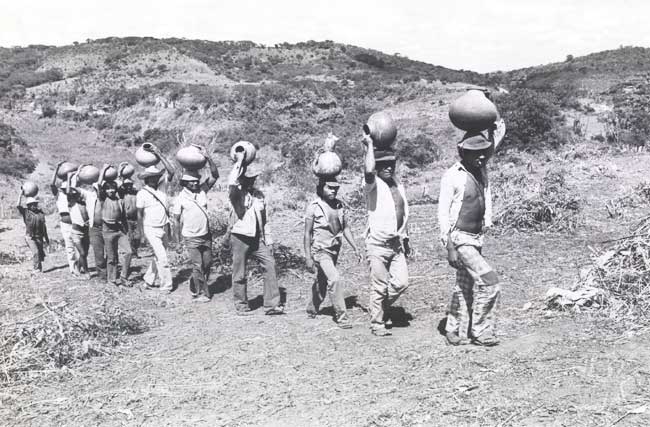
Historically, one could date a first approximation of the Kiriri to an idea of territory – as in the sense that we know it today, with well-defined borders – to the beginning of the 18th Century, the time when the then King of Portugal issued a land-grant of one square league of lands for all of the villages of the backlands with more than a hundred married couples, which was the result of constant requests on the part of the Jesuits because of the conflicts from the expansion of cattle-ranching, especially with large landholders of the region who often interfered in the administration by the parish priests of the villages established there (Bandeira 1972).
Thus, Saco dos Morcegos, one of the four Kipeá-Kiriri villages founded by the Jesuits, which had a population estimated at that time to be 700 married couples, was delimited as had been determined, that is, the size of a sesmaria [plot of land granted by the King] league (6,600 meters), from the center to all parts, that is, following the custom of the time, from the missionary church to the eight cardinal and collateral points, forming a regular octagon of 12,320 hectares (Bandeira, 1972).
The Royal permit that regulated the process of land-granting did not hold up, by itself, for much time as an effective instrument to guarantee the Indians’ possession of these lands, for, after the expulsion of the Jesuits, in 1756, Saco dos Morcegos was raised to the level of a township (in 1760), and became known by the name of Mirandela (Bandeira, 1972).
The establishment of a civil administration in the villages of the backlands set in motion a process of mixture between Indians and colonists, which meant a significant opening up of the indigenous lands to invasion and a strong process of “de-Indianization" which the rest of the Kipeá-Kiriri villages were not able to resist, after being raised to the level of townships and submitted to the administration of the "Directors of the Indians" during the 19th Century (Brasileiro & Sampaio, n/d).
It is very probable that, given their proximity and cultural identity of the Indians residing there, a good part of the population of these townships may have sought refuge in Saco dos Morcegos, and the survival of this population may be attributed to its location further away from the cattle routes and the relative inferiority of the fertility of the soils, in comparison with the other villages. Thus, Saco dos Morcegos was to become progressively occupied by various other non-indigenous peasant segments which had been forced out of precisely those highly valued areas of the Agreste region. Their presence did not drastically reduce the space available for the Kiriri: a small rugged strip of lands where until a short while ago they resided, establishing five marginally located nuclei, surrounded by small villages of the regional population.
Socio-political restructuring
The context marked by persecutions and administrative irregularities which dominated the 19th Century and characterized the action of the "Directors of Indians", who often were opposed to indigenous rights and interests, would become aggravated even more after the extinction of the Directorate, which would contribute to expose in an even more pronounced way the lands occupied by Indians to the greed of the squatters and small ranchers.
Only in the middle of the 20th Century, the lands granted by the King of Portugal would be effectively reclaimed by the Kiriri, mainly after the establishment in Mirandela, in 1949, of an Indian Post of the then Indian Protection Service.
This initiative, the product of unceasing pressures on the Director of the SPI, Marechal Rondon, by the parish priest Renato Galvão, from the neighboring municipality of Cícero Dantas, was preceded by a visit to the Indians, in 1941, of the engineer Luiz Adami, from the Ministry of Agriculture and, in 1947, of the backwoodsman Sílvio dos Santos. Both reports that resulted from this first more official contact with the Kiriri highlight the precision with which these Indians referred to the octagonal format of the chapéu de sol [great tree] that symbolized the territory they claimed, and they drew it, identifying and even locating the eight landmarks that delimited their territory, despite the fact these marks had long ago been destroyed or removed. Lacking these marks, natural landmarks which, roughly corresponded to the original shape, were pointed out:
From the tip of the Peak, to the north, to Pedra da Bica or Suspiro, to the northwest; thence to Pau-Ferro, on the road to Salgado, to the west, place of the present-day village of the same name; from Pau-Ferro to the Pedra Escrevida, in the Juá basin, to the southwest; thence to Pedra do Batico, in the Catuaba basin, far south of the area, on the road to Pombal; from Batico to Casa Vermelha, on the road to Curral Falso, to the southeast; from this place to Pedra do Gentio, to the east; thence to Marcação, an old ranch and present-day village, on the road to Banzaê, to the northeast, and thence finally to the point of origin (Rosalba 1976).
The existence of an Indian Post in Mirandela created an interethnic context that was defined in a much better way, formally legitimating the indigenous identity of the Kiriri and establishing legal protection for the Kiriri in relation to the larger national society. In the 20 years following its installation, which coincided with a phase of general decadence of the SPI, the presence of the heads of the Post was notable mainly for their intermediating of isolated conflicts between Indians and non-Indian occupants of their lands and for their attendance to several of the Indians’ smaller demands, such as construction of schools, a health post, donation of tools, medicine, etc. The question of the territory, the most immediate cause of the effort that culminated in the presence of the agency would not be settled yet during this period.
At the end of the 1960s, the total failure of the tutelary agency (the SPI) could be seen in its post at Mirandela, absolutely unequipped and, more than that, bought by the regional oligarchies. The Kiriri situation at the time was marked by the existence of disputes between indigenous nuclei, by high mortality rates and alcoholism and by attacks that were perpetrated by non-Indians.
In 1972, faced with the total inoperativeness of the tutelary agency –which by that time had been transformed into the Funai- and the overriding need to establish an organizational structure that could at least operate independently and could represent the Kiriri in their struggles with the regional population and the collective struggle for the demarcation of their territory, the Kiriri elected an indigenous leader for the post of "cacique"[chief], besides a council formed by a representative from each nucleus.
In the context of the organizational process that followed the election of chief and councilors, the Kiriri undertook a series of actions that initially were directed at the ethnic revitalization of the group, to formalizing relations with other indigenous peoples and, even, to becoming familiar with the administrative bureaucracy of the State. In 1976, when a head of the post who had a reasonable amount of indigenist experience, political autonomy, and mainly, willingness to back the collective projects of the Kiriri, came onto the scene, such actions took on a more strictly political connotation, being centered on an appeal process for the demarcation of their lands and the removal (expulsion of invaders) from the indigenous territory, based on the sum total of the area granted by the King of Portugal, that is, the 12,320 hectares included in the "square league" and, internally, on symbolic and effective partial appropriations of this territory, which are outlined here as follows: 1979 – Organization of a community garden in the Catuaba basin, situated to the south of the indigenous Territory, on the road that connects the village of Mirandela in the municipality of Ribeira do Pombal, which is characterized by a strong presence of land occupations by the regional, non-indigenous population.
- Demarcation of the Kiriri Indigenous Land, with 12,320 hectares.
1982 – Occupation of Picos, located in the population nucleus of Lagoa Grande, the largest ranch inside the Kiriri territory, considered by squatters and ranchers as a stronghold in the occupation of the indigenous lands. Its supposed owner, Artur Miranda, was supported by politicians of the region and considered by the Indians as their worst enemy.
1985 – Occupation of a ranch of 700 hectares in the Baixa da Cangalha.
1986 - The Kiriri close off an important access road from Mirandela to the village of Marcação, removing all the belongings and gardens of the non-indigenous population located in the area.
1987 - The FUNAI pays indemnities and the INCRA resettles 37 families of non-Indians who were living in the Kiriri territory, on the Taboa and Serrinha ranches, situated in the municipality of Quijingue. 1989 - 85% of the Kiriri territory is now considered to comprise the municipality of Banzaê, which is administratively cut off from Ribeira do Pombal, a political manoeuvre with the intent of “freeing” the latter municipality of the indigenous presence. Mirandela had been strategically chosen as the capitol of the new municipality. Yet, through injunctions in the Legislative Assembly, in Salvador, the Kiriri are able to prevent the new capitol from being situated within the borders of the Indigenous Land.
1989 - Around 50 Kiriri families camp out around Mirandela, after their houses were partially destroyed by a flood. They stay permanently in the place which came to be, until 1995, a nucleus of pressure against the non-Indians who still occupied Mirandela. 1990 - The Kiriri Indigenous Land has its administrative demarcation homologated through Decree nº 98.828, of January 15, which was later registered in property records - Reg. CI mat. 2969, book 2m, f. 83, on 23 March of that same year.
1991 – The FUNAI provides indemnities for several houses inhabited by non-Indians in Mirandela and Kiriri families occupy them.
1995 - The Kiriri occupy Mirandela, removing all the non-Indians who were present there.
1996 - The Kiriri occupy the village of Gado Velhaco, situated 2.5 Kilometers from Mirandela.
1997 –The non-Indians disoccupy the Baixa da Cangalha.
1998 - The Kiriri occupy the villages of Marcação, Araçá, Segredo and Pau Ferro, removing the last families of non-Indians residing on the Indigenous Land.
Location
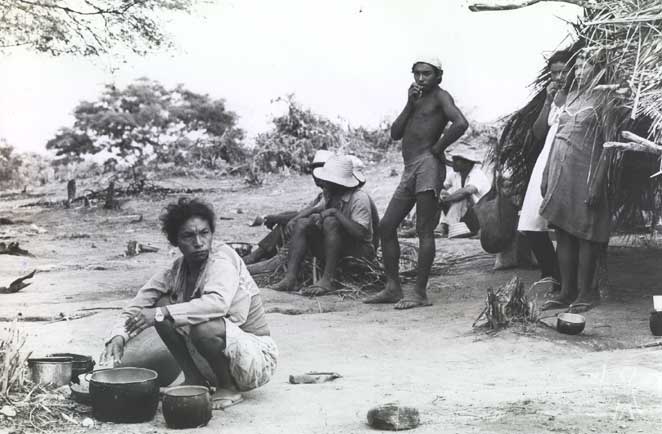
The Kiriri Indigenous Land covers an area of 12,300 hectares and is located in the north of the state of Bahia, in the municipalities of Banzaê (95%) and Quijingue (5%), which is a region of semi-arid climate, a transition zone between the humid agreste and the caatinga ("mouth of the caatinga"). The geographical relief of the area is irregular, with flat-topped hills and slopes intermingled with extensive plains. The water courses are intermittent due to the low annual rainfall. One observes a marked devastation of native species, an accelerated process of erosion caused by more than three centuries of economic exploitation. Mirandela, the center of the Indigenous Land, is situated 24 kilometers to the northwest of the city of Ribeira do Pombal, the most important economic center of the region.
The traditional nuclei of Kiriri settlement - Sacão, Baixa da Cangalha, Cantagalo, Lagoa Grande, Cacimba Seca – have more recently been substituted by the villages which before were occupied by the non-indigenous population: Mirandela, Gado Velhaco, Marcação, Araçá, Pau Ferro, Segredo, Baixa do Camamu, Baixa da Cangalha ("Biombo")
Productive activities
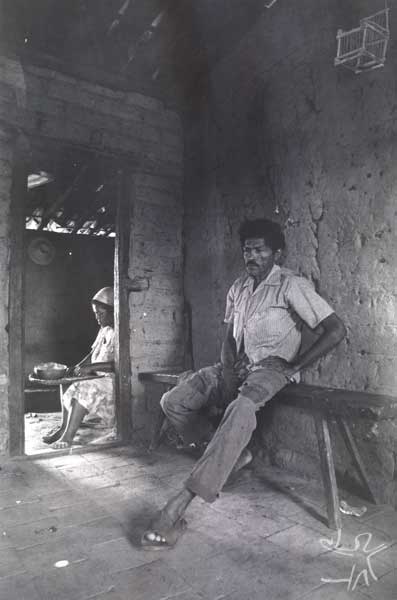
Generally speaking, the Kiriri practice a form of subsistence agriculture, although they commercialize, sporadically and in small quantities, surpluses from their gardens of temporary cultivated plants – consisting basically of manioc, beans and corn – and various kinds of vegetables cultivated in small gardens, preferably located in the back yards of their houses. Out of all their production, part is set aside for domestic consumption during the year, part re-invested immediately in supplies and in articles necessary for the reproduction of the family unit. Another strategy which is frequently used is the creation of a small reserve set aside for the gradual acquisition of goods, as well as seeds for the next planting.
The economic activities of the Kiriri are, in a certain way, directed to the regional market, given that specialization in goods produced, as well as the nature of the agriculture they practice, restrict the possibilities of the existence of a semi-autonomous community, which means they have to maintain active communication with the nearest commercial centers, which the Kiriri frequently visit to commercialize their products for the purpose of acquiring highly needed goods and which are not produced locally, such as meat, coffee, cooking oil, sugar, salt, besides various other articles of less immediate consumption.
The products of gathering forest fruits, such as caju, umbu and pine cones are also set aside, more or less regularly, for sale on the market, as well as, more sporadically, artwork of ceramics and weaving. Based on the information gathered by Bandeira at the end of the 1970s, it is supposed that historically this artwork may have been an important item in the Kiriri economy; it is still today, moreoever, one of the factors of ethnic differentiation. In the last few years, as a result of the intensification of contact among indigenous peoples, the Kiriri have begun to produce, although in small quantity, collars and other kinds of ornaments similar to those commercialized by the Pataxó, in Porto Seguro and Santa Cruz Cabrália.
The cycles of planting and gathering of each cultivated plant should be organized in such a way as to provide for the minimum subsistence of the domestic group during the agricultural year. White beans, also known as "carioca" or "harvest beans", are, among the Kiriri, planted together with and at the same time they plant corn: from the end of April to the end of May, the harvest taking place from August on. “Green” beans on the other hand or “branch beans" - the "ligeirinho"[light, quick] – also associated with corn, are planted in February, and normally are gathered from March to mid-July. Manioc, a crop with a reasonably long planting cycle – from a year and a half to two years -, is gathered in the months of June, July and August, when they begin the production of manioc flour, the so-called "farinhadas".
The Kiriri presently have houses for mechanically producing manioc flour, which belong to the community, and were set up by the Funai, which progressively have substituted the manual production of manioc flour, which was done by each family. In these new units, each domestic group freely produces its manioc flour, paying a small quantity for utilizing the machine – to the FUNAI or to its administrators, in this case, the councilors, in each nucleus – the corresponding amount in manioc cereal, to the diesel oil consumed.
Following the regional peasant pattern, the Kiriri nuclear family is the basic units of production and consumption, and the labor of all its members, from childhood on, is constant and necessary to their socio-economic reproduction. The diversification of the gardens, often distant from one another, constitutes a prevention measure against eventual failures in one or another area, both due to the scarcity of fertile lands, and to the need for taking advantage of the different types of available soils.
Besides the work done in the narrow circle of the domestic units properly speaking, there still exist strategies of inter-familiar cooperation, commonly called “batallions", or "aggregations", in which, generally speaking, only members of the ethnic group participate. This is one of the ways in which they assume "exchange of days", which, in contrast with "hired", or "rented" labor, is characterized by a symmetry in the relations among the parts involved. Based on kinship groups, or on neighborhoods, a ‘battalion’ joins together a varying number of individuals who make an agreement amongst themselves, in such a way that, each day, everyone works on the garden of one person. It is up to the so-called “owners” of the battalion – owners of the garden which is to be worked – to provide the food necessary for the “work group" so constituted.
Another form of "aggregated labor" observed among the Kiriri is the "called-up battalion", which is formed for the purpose of executing certain tasks, such as the building of a residence, schools or even the clearing of new gardens. For these occasions, invitations are made well beforehand, and a significant number of “kin”, neighbors and friends will appear, who take part in whatever food and drink there may be.
In the Kiriri gardens, as among the other peasant groups of the region, the technology used basically includes hoes, enxadecos [a type of hoe], machetes, plough, scythe, among other things. In general, the Indians don’t use materials such as artificial fertilizers or agro-toxins ("poisons"). In planting, they frequently make associations among cultivated plants and their alternating succession, practices which are considered as adequate in view of the reduced areas of land available for agriculture.
Given the scarcity of goods for production, the soil factor takes on a special importance, determining the productivity of the agriculturalist. Without fertilizers and chemicals added to the soil, the location and natural fertility of the land are decisive factors for the Kiriri.
The activities of the agricultural year are organized according to a seasonally determined variation in the intensity of labor required, with a notable difference between the periods of winter and summer, that characterize the agricultural calendar and, by extension, the rhythm of life in the region, concentrating or dispersing the available labor force. During the critical periods of the summer, when the amount of labor necessary for maintaining the individual and community gardens diminishes, it often becomes absolutely necessary to rely on other strategies of labor production and it is very common, at these times to work as “hired hands” or “day laborers" – ways of earning salary – and even migration.
The ritual of the toré
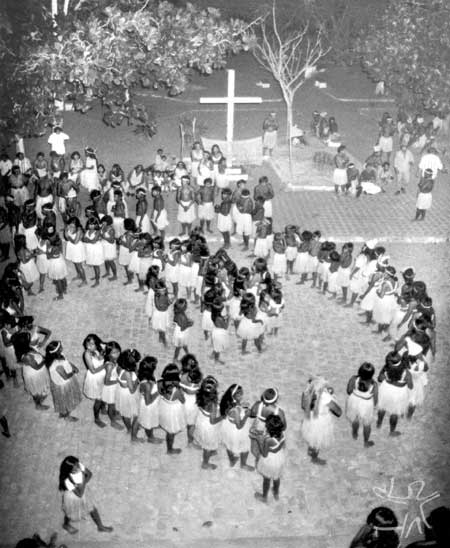
In 1974, Kiriri leaders organized a caravan of about a hundred Indians going to the Tuxá Indian Reserve, located in Rodelas, north of Bahia, at first to hold a soccer match between the two people, but also with the clear intention of watching the ritual of the Toré which the Tuxá danced, and to learn how to do it. The Toré is part of a wider set of beliefs – at the center of which one finds the use of jurema – which, very probably, could have been grouped together into a ritual complex which is common to the peoples of the backlands (Cf. Nascimento, 1994). Among the Indians in the Northeast, the Toré represents a symbol of unity and ethnicity, a provider of ideological elements of unity and differentiation and thus, a source of legitimating their political objectives.
The process of adopting the Toré is best made viable on the symbolic plane, on the one hand due to its relation with certain shamanic practices still in operation among the Kiriri, selected with attention to the criteria of ethnic representation. Once the Toré had entered the scene, these practices were progressively de-legitimated and those that did not adapt to the procedures used in the rituals, that did not "ally their guides to the guides of the Toré", were marginalized, prevented from "working".
The Kiriri introduced new elements to the structure of the Toré they had learned: their "enchanted beings" (supernatural beings), were added on to those borrowed from the Tuxá, and progressively assume ever greater importance; The Kiriri added their own rhythms and choreographic variations to the original melodic repertoire and the costumes underwent changes (Martins, 1985).
The Toré is generally held on Saturday nights – there being only interruption during the period of Lent – on large dance spaces next to which there is always some closed off space, where the pot with the “jurema” is kept and private sequences of the ritual are held. The ceremony begins with the concentration of peoples in the area around the dance space and in the closed off space where the blowing of tobacco smoke begins, which is then extended onto the dance space; the tobacco smoke is blown from large cone-shaped wooden pipes, with drawings carved or painted onto them. The ingestion of the jurema also begins at that time, which will be intensified during the dance; it is distributed by the local councilor or by some other notable figure in the ritual and political hierarchy. Dancing onto the dance space, they go on with the works of "cleaning", which are led by the pajé, when, at that time, using whistles, the "enchanted beings" are invited to participate. They begin the songs and dances, at first in Indian file, with the pajé up front, followed by the men, women and children, in that order. The line of dancers moves in snakelike fashion over the dance space in dance steps which are progressively elaborated to the degree the rhythms follow one after another, intensifying the involvement of the participants, until the climax that comes with the “arrival” of the “enchanted beings", which can be seen in evident signs of incorporation demonstrated by the female "masters".
By that point, moods are altered and the horizontal hierarchy of the Indian file gives way to movements around the possessed dancers who occupy a central position on the dance space and move very little, while they begin to speak in a language which is supposedly indigenous, a ritual that consists of a sequence of much repeated sounds that are incomprehensible for the Kiriri today. They are then led to the closed off space, the “little room" – where they are consulted in relation to the most varied questions, providing counsel of a generic nature, that, as a rule, reproduces the ideas of group unity. The main interlocutors and interpreters of their messages are the political leaders of the Kiriri and especially the pajés (Rocha Jr., 1983).
Language and social organization
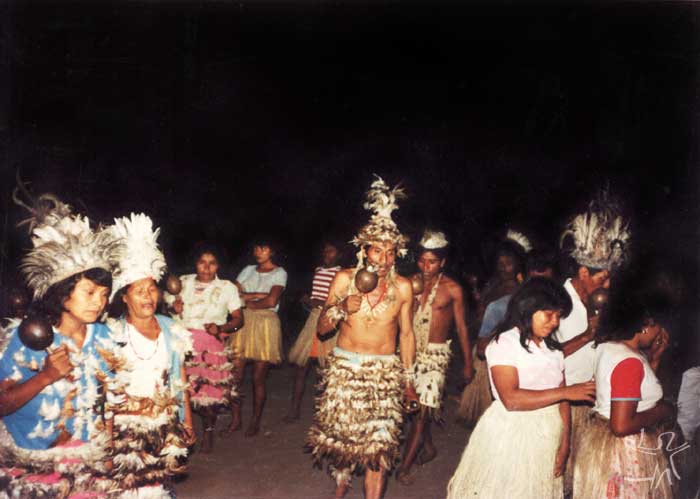
Today they only speak Portuguese, although they sporadically utilize several fragments of the Kipeá dialect, which is of the Kariri language family.
At the end of the decade of the 1980s, the Kiriri duplicated their political structure, organizing themselves into two factional segments – presently the most effective units of formalized political action in the group – led by their respective chiefs, pajés and councilors. Each chief is assisted by his councilors, "local chiefs" who are responsible for the administration of the nuclei, which form the smallest Kiriri political unit. Historically, these nuclei are the areas where the Kiriri settled, while they were being expelled, ever since the end of the missionary settlements, from their center in Mirandela. Each one of these nuclei, six in all, comes under the authority of a councilor, with an “assistant” as second-in-command. The recently-expelled villages come under the authority of the councilors of nuclei adjacent to them.
Among the Kiriri population, there is a migration of a more or less permanent character resulting from political conflicts and inherited fissioning. The Kiriri still undertake with relative frequency, seasonal migrations, but invariably return at the times of planting and harvest. They migrate principally to São Paulo and Rio de Janeiro, or to regions close by like Sergipe, or even to the ranches in the neighboring regions. In these places, they work for long hours of the day, for the time that allows them to accumulate a minimum amount of capital, which will then be reinvested in their area of origin, thus making viable the reproduction of their peasant condition.
Sources of information
- BANDEIRA, Maria de Lourdes. Os Kariris de Mirandela : um grupo indígena integrado. Salvador : UFBA, 1972. 172 p. (Estudos Baianos, 6)
- BRASILEIRO, Sheila dos Santos. O “caso Kiriri”. In: ESPIRITO SANTO, Marco Antônio do (Org.). Política indigenista : Leste e Nordeste brasileiros. Brasília : Funai, 2000. p. 79-86.
. Organização política e o processo faccional no povo indígena Kirirí. Salvador : UFBA, 1995. (Dissertação de Mestrado)
- --------. Povo indígena Kiriri : emergência étnica, conquista territorial e faccionalismo. In: OLIVEIRA FILHO, João Pacheco de (Org.). A viagem de volta : etnicidade, política e reelaboração cultural no Nordeste indígena. Rio de Janeiro : Contra Capa, 1999. p. 173-96. (Territórios Sociais, 2)
; SAMPAIO, José Augusto Laranjeiras. Os povos indígenas na Bahia. Salvador : Anai-BA, s.d.
- CARDIM, Fernão. Tratados da terra e gente do Brasil. São Paulo : Ed. Nacional ; Brasília : INL, 1978. 266 p. (Brasiliana, 168).
- CORTES, Clelia Neri. A educação é como o vento : os Kiriri por uma educação pluricultural. Salvador : UFBA, 1996. 158 p. (Dissertação de Mestrado).
; MOTTA, Erimita (Orgs.). História da reconquista de Mirandela - História à varias vozes. Brasília : UFBA, 2000. 31 p.
- GERLIC, Sebastián (Ed.). Índios na visão dos índios - Kiriri. Salvador : Índios na Visão dos Índios, 2003.
- MARTINS, Marco Aurélio. O toré na Lagoa Grande. Salvador : s.ed., 1982. (paper).
- MASCARENHAS, Maria Lúcia Felício. Rio de sangue, ribanceira de corpos : 1893/1897, Kirirí e Kaimbé em Canudos. Salvador : UFBA, 1995. (Monografia Bacharelado em Antropologia)
- NASCIMENTO, Marco Tromboni. O tronco da jurema : ritual e etnicidade entre os povos indígenas no Nordeste - o caso Kiriri. Salvador : UFBA, 1994.
- REESINK, Edwin. Raízes históricas : a Jurema, enteógeno e ritual na história dos povos indígenas no Nordeste. In: MOTA, Clarice Novaes da; ALBUQUERQUE, Ulysses Paulino de (Orgs.). As muitas faces da Jurema : de espécie botânica a divindade afro-indígena. Recife : Bagaço, 2002. p. 61-96.
- RIBEIRO, Eduardo Rivail. O marcador de posse alienável em Kariri : um morfema macro-jê revisitado. Rev. Liames, Campinas : Unicamp, n. 2, p. 31-48, 2002.
- ROCHA JÚNIOR, Omar da. O índio é de menor : os Kiriri e o movimento indígena no Nordeste. Águas de São Pedro : s.ed., 1983. 26 p. (paper).
. O movimento Kiriri. Cadernos do Ceas, Salvador : Ceas, n.97, p.29-39, 1983.
ROSALVA, Lélia Maria Fernandes Garcia. O Posto Indígena de Mirandela. Boletim do Museu do Índio, Rio de Janeiro : Funai, n.1, 69 p., 1976.
- SARMENTO, Paulo Souza. Atitudes e representações diante da morte : alguns elementos para uma definição da concepção de morte Kiriri. Salvador : UFBA, 1995. (Dissertação de Mestrado)
- Mirandela Kiriri. Dir.: Joao de Mattos. Video cor, Hi8, 18 min., 1996. Prod.: Pinep/Anai.
- WOORTMANN, Ellen F. O sítio camponês. Anuário Antropológico, Rio de Janeiro : Tempo Brasileiro, v.81, p.164-203, 1983.